The Sequential Circuits Six-Trak is one of the few (small) analog synths that really took me by surprise! Sadly enough, I had just decided to part with the instrument when I discovered its enormous potential! There was a small chance that the buyer might loose interest in the deal, but of course … he didn’t!
So I’ve spent the last few days with my Six-Trak, recording samples for a review. With each soundfile, I became more aware that selling this beauty was one of my biggest mistakes.
This was in 2009. In the meantime, I bought another Six-Trak, of course. Just couldn’t live without it.
But let’s start way back in the 70s. Imagine you’re one of those ancient Greek semi-gods, and you’ve been sitting on a cloud for thousands of years just watching what’s going on on earth. Being immortal, this is quite a boring life. But in 1978, the amazing Sequential Prophet-5 is borne. The humans on earth are happy and delighted, it’s the dawn of a new era …
A few years later … everything’s back to normal, except for a bit of clamour as that little devil Sequential Pro-One takes the continents by storm. Essentially, the 8-voice Prophet T-8 has sunk back into oblivion. There are lot of confusing new toys, many little boxes, few buttons … all essentially strange instruments! Whether a Six-Trak, a Max, a Multi-Trak, a Split-Eight or whatever … names come and go.
Or so I, humble person, thought!
The Sequential Six-Trak turns out to be a brilliant musical instrument. Despite its small size, it is capable of stunning, great, modular-like, powerful electronic sounds. It offers 100 memories (factory presets by John Bowen), its keyboard action is very pleasant (a billion times better than any Pro-One keyboard), it has 6 voices and is multi-timbral. Its vast sound architecture sports 3 (!) fully equipped envelopes (digital, sadly), filter-FM, and much more. And… the Six-Trak has MIDI!
MIDI? It’s not an ordinary note-on/off communication bus, but a powerful MIDI implementation with Midi CC-features for all parameters. And it’s so easy to handle! Just tell your sequencer which CC-number needs to be controlled, and there you go! With those great MIDI facilities, the Six-Trak comes close to a small modular system. And, in some ways, it’s even much better! Attack-time, decay, filter resonance, mix of osc/noise signal, amount of filter-FM… it’s all CC-controllable! It’s really amazing. I’m always a little critical toward vintage MIDI (analog) synths, but this one is a cracker! It’s easy to handle, and it’s definitely a creative musical instrument!
Soundwise, it’s an amalgam of many of its predecessors. Unison sounds remind you of the classic Prophet-5, while many of the unexpected, crazy-effect sounds remind you of the Pro-One. Lead sounds are wonderful, so… to make it short… this IS a serious, fully equipped Sequential synth with many pros. Unlike its older brothers (except the Prophet-600), it has six voices, is fully MIDI equipped, and has enormous sonical potential despite its small size. On the other hand, it’s lacking Poly Modulation, and has no CV-inputs (such as filter cv-in or cv/gate). The missing inputs, of course, don’t really hurt, due to the comprehensive MIDI options. The hardware is typical for those early/mid 80s Sequential keyboards – semi-professional knobs (like those of the Prophet-600 and Pro-One), rubber buttons (which might eventually occasionally refuse to work), plus a slimmed-down chassis that contains a four-octave keyboard with the controller section above the keys (and not to the left).
To me, the Six-Trak is a pretty-near-perfect instrument for the creative sound enthusiast. If I was one of those ancient, Greek semi-gods – sitting around on a cloud for thousands of years – I’d immediately buy a Six-Trak. It’s so much fun, and it’s amazingly flexible. On top of everything else, it’s the perfect instrument to carry around, weighing slightly more than a bar of chocolate …
Important MIDI-info (c) by David Barnhard.
Six …
Each of the instrument’s six voices contains…
- a VCO (with waveforms saw, pulse with PWM, and triangle) – all waveforms may be freely combined and used simultaneously
- an LFO (saw and pulse wave)
- a 24 dB lowpass VCF
- a VCA
- 3 ADSR envelopes (for OSC, VCF and VCA)
The following Midi Control Chart lists all of the instrument’s sound parameters. It’s an excerpt from David Barnhart’s great Six_Trak_CC_Chart PDF that’s available below for download … (I hope to have your permission, David, as I found no way to contact you). It’s important to know that the Six-Trak is – as described above – not ready for MIDI-CC when switched on! You need to press “Control Record” and “4” simultaneously to activate the required MIDI mode.
After that, it’s simply a question of telling the computer (or sequencer) which parameter needs to be controlled. That’s it.
The full PDF is available below. All (c) by David Barnhart.
Apart from its respectable sound architecture, the Six-Trak offers some other goodies. First, an 800-note multi-timbral sequencer. Second, a simple (and useful) arpeggiator. Both the sequencer and the arpeggaitor may be synched by MIDI clock (although – rumour has it – only by Sequential drum machines). Third, there are tons of performance tools, such as glide, polyphonic portamento, voice assign mode, unison mode, and the great stack mode. The latter allows for stacking up to six sounds and firing them up by hitting one key. The Six-Trak is a six-voice multi-timbral synth with a maximum of six sounds at a time. Using six different sounds simultaneously limits you to monophonic playing, of course.
Performance
Well, there are also a few less positive aspects of the Six-Trak worth being mentioned. It’s not the completely perfect machine, and you probably won’t be suprised if I tell you that this is not a Prophet-5 with extended MIDI functions. Those among you who read through the MIDI-CC chart with care might have noted that all parameters use a very low resolution. Filter cutoff, e.g., has a maximum of 7 steps, while attack time offers 4 steps only. All parameters are somewhere between 1 and 7. That’s not really heaven on earth! Take the envelope’s parameters: there are huge sonical differences between parameter value “2” and “3”. Sadly enough, there’s no way of circumventing the low (MIDI) resolution. But, on the other hand, reduced MIDI allows the Six-Trak to receive many CC-tracks at the same time. I prefer controlling 10 sound parameters simultaneously with low resolution to just one or two parameters with higher resolution.
The internal resolution of parameters is much better, of course. But, as with the Prophet-600, you hear zipper noises when changing values while the instrument is playing. This is a concession to the early digitally controlled (analog) synths that we need to accept.
A major difference between the Six-Trak and the wonderful Sequential Pro-One is digital (versus analog) parameter control. With the latter, you won’t be bothered by zipper noises, there is no low-parameter resolution, etc. The Pro-One is a perfect (monophonic) instrument for detailled sound programming.
Just the same, I’m not sure which of the two is the better machine. Let’s forget about bad parameter resolution (and digital envelopes), and concentrate on the Six-Trak’s positive aspects. Stacking six voices simultaneously is quite unique and gives the instrument enormous power. Each of its parameters can be individually controlled via MIDI – not possible with the Pro-One. I like to think of the Six-Trak as being a Pro-One with a huge patch-bay (which, of course, would turn the monophonic classic into a modular monster!). Yet, the (digitally controlled) Six-Trak does offer complete controllability via MIDI, and – best of all – it’s a cute, light machine.
One gorgeous feature of the Six-Trak is its Filter FM. It’s responsible for all those ring-mode-like, weird fx-sounds. Filter FM means that the onboard oscillator is used as a modulation source for filter frequency. The sonical results vary (sometimes to the extreme) depending on the OSC scaling and its active waveforms. This is a great source of effect sounds.
Now, imagine this onboard oscillator (that modulates the filter) to be modulated by its own envelope. And let’s go even a step further and control each of the envelope’s parameters via MIDI-CC… I guess you get an idea of how powerful and flexible the Six-Trak can be. Its programming depth is really impressive.
Sound – magic of the CEM 3394 synth-on-a-chip?
The Sequential Six-Trak is a surprisingly flexible source of quality electronic sounds. You get rich, broad unison-killers and lovely, shimmering pads, typical Prophet-leadsounds as well as spectacular, unheard effects. To me, it’s an amalgam of many Sequential synths in one box (the later Prophet-VS being the one exception, of course … an now, there’s the brilliant John Bowen Solaris, too).
I think the Six-Trak sounds wonderful… it’s as simple as that and that’s all I can say.
By the way – the Six-Trak uses a synth-on-a-chip for each of its six voices. The Curtis 3394 combines VCO-VCF-VCA in one single component, making the basic sound architecture of the Six-Trak totally analog – except for the digitally generated envelopes. That little Curtis 3394 might be one reason why the Six-Trak has a less “classic” (Prophet-5 like) sound. But the overall sonical potential (“what you get for what you pay”) is amazing, and that’s the point!
You get addicted to the Six-Trak! Let’s imagine it’s Sunday morning. Right after breakfast you turn on the instrument and start playing. You step through the pleasant presets, play lush six-voice pads with some slight vibrato (mod wheel), and start changing attack-time and decay. After modifying filter frequency and resonance you turn on the arpeggiator, and soon get lost in landscapes full of arpeggiated sequences (while continuing programming, of course). Right after that you attach an external MIDI sequencer that plays a lovely loop while you feed it with interesting control tracks that gradually change the Six-Trak into an effect-sound-/weird-noise-monster. Now, while you’re still in your only-me-and-the-Six-Trak world, you recognize it’s almost midnight and time for bed …
I intended to record just a few samples for this review, but those few turned out to be 20 minutes of audio-material now. I couldn’t stop exploring this wonderful little analog instrument. If only I haven’t promised to sell it…
Connections
There’s not much to discover on the instrument’s rear panel. Four sockets, that’s it. MIDI IN and OUT (no THRU!), FOOT SWITCH IN and AUDIO OUT (serving as headphones output, too).
In a perfect world, the Six-Trak would feature individual outputs for each of its voices. This feature is to be found on its successor, the Sequential Multi-Trak from 1985 (mentioned below)! Further, stereo audio output would have been wonderful! Plus the possibility for panorama positioning each voice … some of the typical Oberheim OB-8/Xpander features would have been excellent here.
Hardware and User Interface
Well, let’s be honest. The Six-Trak is not made of high-end components (not at all). Its brittle knobs remind you of the Pro-One/Prophet-600, and its rubber switches might just stop functioning bye and bye.
Nonetheless, if a Six-Trak comes in respectable condition, it is a reliable and superb instrument. The keyboard action is well balanced, and its handy design provides for rapid workflow.
Programming the Six-Trak is not as easy as with most of its famous predecessors. With only a single value knob, you’re forced to select a specific parameter first, before editing. A little map printed on the instrument’s surface lists all parameters, so at least you don’t have to think too much when actually programming. Regarding the (low) original retail price, the Six-Trak offers sufficient hardware and a well thought-out user interface for its money. But it can’t be compared with any (pricey) Prophet, of course …
Speaking about hardware, let’s switch to some newer instruments for a moment. I get really irritated at how important coloured wheels and backlit options seem to be for users these days. Have you seen the upcoming Prophet-12? Looks superb, no doubt! But I’m a little sceptical of all these illuminated panels. They look more like a cockpit than an instrument. The fact is, you get no musical gains from any of those snappy designs.
Take the Moog Voyager, for example. My curiosity about its behaviour if a regular VCO from a modular system were connected to its Filter-CV-IN port was answered by total disappointment at the sonical results. The sound of this (external) filter FM was not comparable to any original Minimoog or any other classic vintage synth. The Voyager simply didn’t reprocess the external modulation source well. That’s when I realized I prefer doing without coloured wheels and backlit options, in exchange for an instrument with high quality technical components.
A few years ago, I listened to the first Prophet-08 sound demos. None of them reminded me of the Prophet-5. Ok – maybe this was supposed to be a instrument of its very own! But I suspected (and still suspect) modern synth industry is concentrating on visual effects and trendy designs rather than investing all their efforts in high quality technical components that would eventually lead to better audio quality in their instruments. Maybe backlit wheels are cheaper (and a lot easier to sell) than high-end sound modules. It’s a complicated business.
Note
You need to be a little patient when programming the Six-Trak. Choose a parameter, dial-in its number, switch to value and turn the value knob. Adjustments are clearly visible in the small two-character display. Then choose another parameter and start the whole procedure again. I did this for hours and hours.
But there was in fact an easier way …
Once you have selected a parameter, the value knob is ready for use. Simply turn it and listen as the sound changes. You don’t NEED to enter value mode – it only shows the exact parameter’s value in the small display, that’s all! A skilled programmer (having most of the programming steps in mind) simply chooses certain parameters and edits them in free flow via the knob. Value mode needs to be referred to only occasionally – as when you want to check whether a certain function is on or off (value 1 or 0).
Be careful – some parameters have a resolution of more than 100 – like 127. There are two options on how to read the two-character display… “27” could be “27”, but also “127”! It’s better to turn the value knob far to the right, to make sure you’ve got the maximum value.
All in all ...
… the Sequential Six-Trak is a wonderful musical instrument. It has tons of interesting features, such as stack mode, unison, a multi-timbral sequencer, an arpeggiator with assign-mode, a full list of MIDI-CC parameters, etc. Of course there are a few limitations: there’s no individual output for each voice, there’s only one value knob for editing, some of the rubber parameter/program switches might just stop working… But all in all, I’d give it a 8 out of 10! The hardware is sufficient (and in many ways better than with the Pro-One, e.g.), the user-interface is well thought-out, and – last but not least – the sound is neat and meaty.
Those looking for sonic overkill should focus on a Prophet-5, while pure keyboard players might be happier with the wonderful Prophet T-8. Those again who prefer a modern cockpit feeling in their studio might buy a Prophet-08 or Prophet-12, while musicians looking for the classic Sequential sound (including those lovely soft analog pads) might go for a Prophet-600. Monophonic enthusiasts are recommended to concentrate on the Pro-One, and the rest … well, the rest either needs no Sequential synthesizer at all, or might keep a look out for a Six-Trak. It produces FX-sounds (similar to a Pro-One), has some lovely, soft pads (as with the Prophet-600 and, to some extent, the Prophet-5), and sports a comprehensive MIDI implementation (unlike any Sequential before 1984).
This is quite an instrument, really!
… and well, if purchasing a 30-year-old analog synthesizer seems too risky, you could also consider alternatives. Think of the DSI Mopho x4, for example. A modern analog machine by Dave Smith – an instrument that looks very similar to its ancient predecessor Six-Trak, by the way …
PS: In the literature, Sequential’s Multi-Trak is often mentioned as the Six-Trak successor. This isn’t quite correct. Sure, the Multi-Trak is beautiful, it’s a slim and modern-looking 6-voice analog synth. Same sound architecture as the Six-Trak, 6 individual outputs, stereo chorus, a better editing system (matrix system) and a 5-octave velocity sensitive keyboard. BUT … it does NOT allow for MIDI CC control over the parameters. It’s more of a good performance synthesizer than an in-depth-programming MIDI tool.
PPS: Bob Grieb recently developed a MIDI upgrade for the Multi-Trak. Perhaps the Multi-Trak will be one day as powerful as the Six-Trak …? See Grieb’s website www.tauntek.com/SCIMultitrak.htm and search on Youtube for detailed information.
Download David Barnhart’s great Six_Trak_CC_Chart PDF here: six_trak_cc_chart
We have added 20 minutes of Six-Trak audio-material.

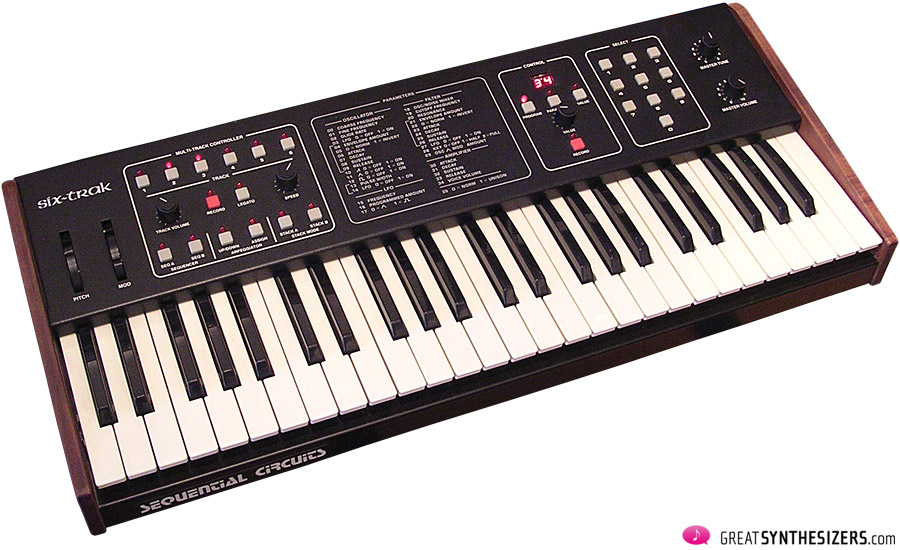



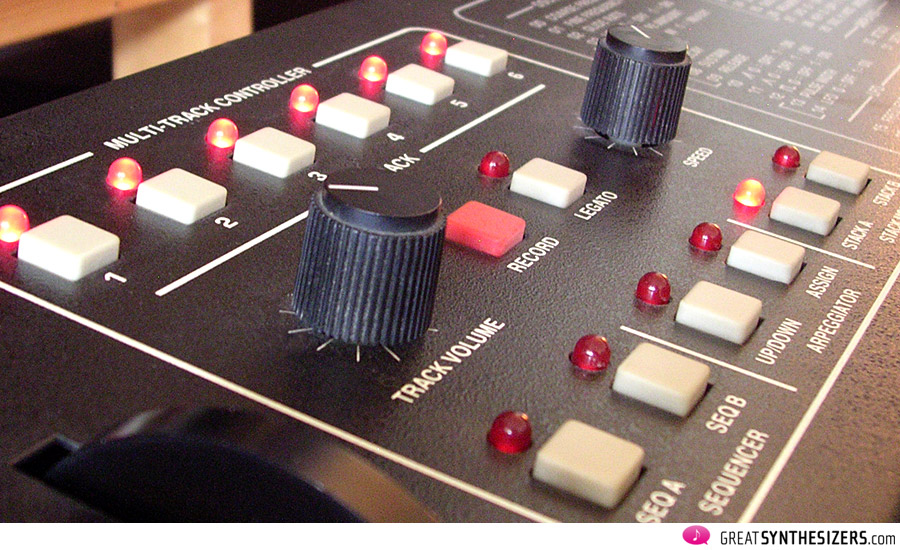
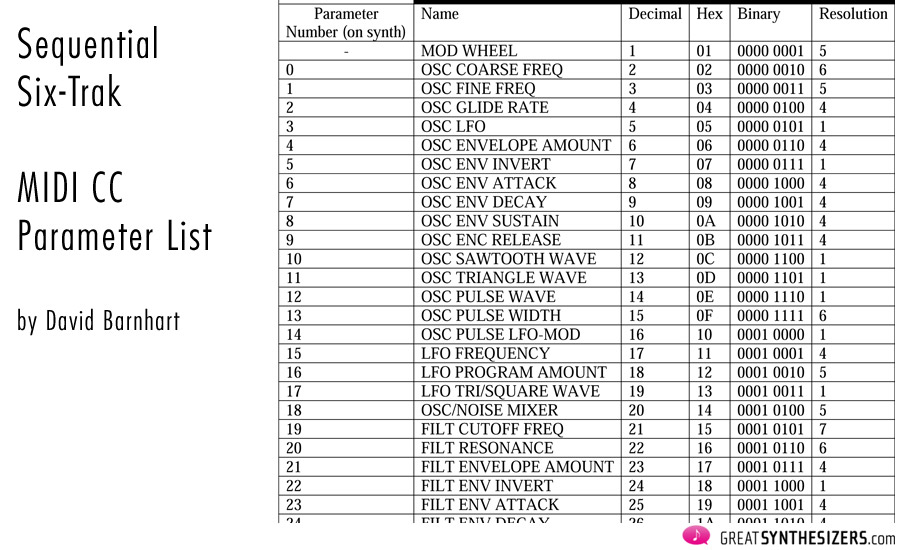

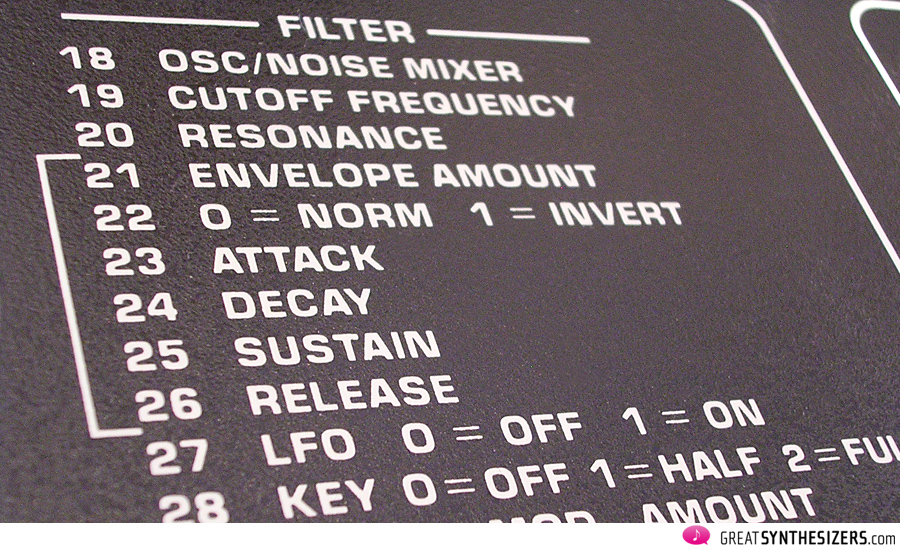

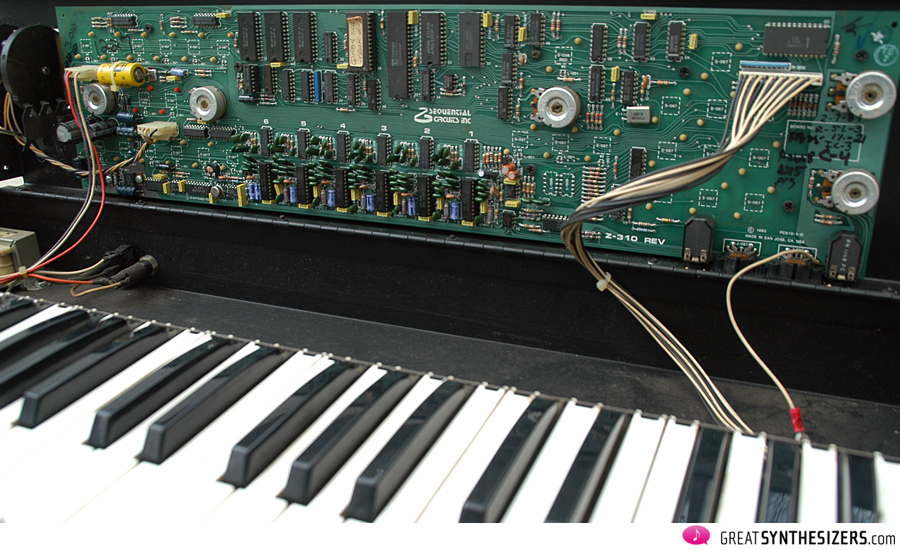




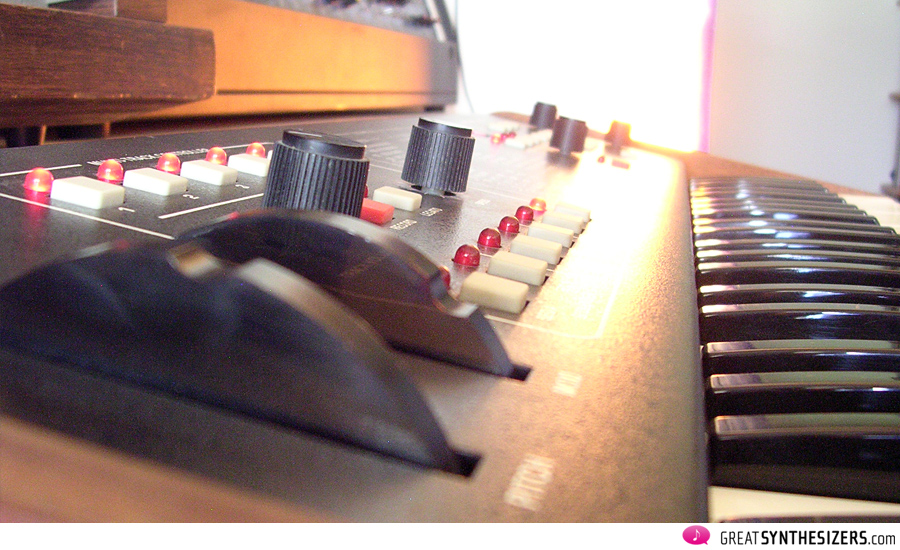

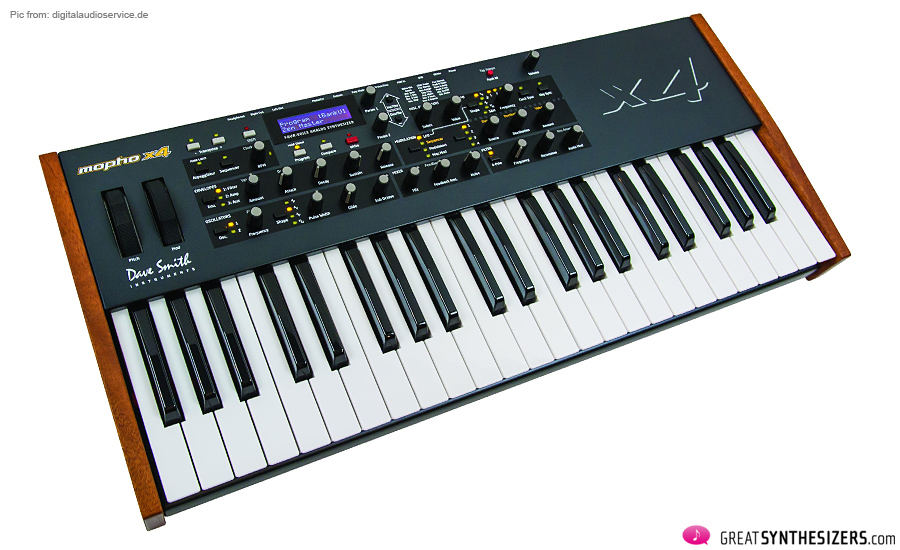
don’t know about the sixtrack but i own/ed (among other sequentials)
the multitrack and the split 8 , the multitrack albeit like it looked as
an updated 6-track on paper was a real duffer in the sound department , very sluggish env’s /no attack to the sound , very poor s/n noise ratio
from the synth on a chip curtiss cems , a chorus that actually managed to worsen the sound instead of improving , the 6-track
had a preset only sisterkeyboard ‘the max’ wich came in silver and had a tendency to get a ‘rusty’ frontpanel due to poor quality manufacturing
The resolution is actually much better than you state. The 1-7 refers to bits of resolution, not the number of steps. 7 bits (for filter cutoff) is equal to 127 steps, which is the same number of steps you have on the Six-Trak itself.
Great review of a still-hidden gem of a synth.
I love my SixTrak, even though ALL the rubber buttons are dead… for the second time (I need to go through and replace the contact pads with proper click switches, instead of contact paint.)
And yes, it really can sound like a modular!
Imagine all the de-tuning and separate LFO rates you can get under one key. Or the huge fierceness.
BUT… the tone IS a little thin. This cannot be the CEM3394 chip, as some commentators have claimed – that’s the same chip as in the Doepfer Dark Energy, and that synth rips ass.
So maybe, it’s the mixing/switching stage at the end that sucks tone. Not beyond the possibilities of experimentation and change.
I upgraded mine in the 90s with the Wine Country firmware ROM, which gives the sequencer much better MIDI sync to other synths… but still the arpeggiator only responds to pulses at the footswitch socket, and not MIDI.
I’ll learn from your mistake there, and not even consider selling :-)
… thanks for the additional info (Wine Country firmware ROM – MIDI sync, …). And yes, never (!) sell the Six-Trak :o)
The poor sibling the MAX now has a new lease of life too. Often looked on as a poor relative of the six-track, it’s all the same synth, 6 voice poly, multi-timberal and with the same full spec MIDI CC implementation (better than some new analog synths!).
The Tauntek ROM/RAM upgrade gives the MAX the missing unison mode and storage of 100 patches, and 3 banks of built in patches, all the patches from the MAX, six-track and multi-track. Also addresses limitations with the MIDI buffer and sorts out the issues of saving a patch created by CC edits.
I’ve just modified mine, giving this old beast a new least of life. It sits well in a modern setup, given extensive MIDI spec I can control and edit patches from my controller keyboard and even from my iPad. Happy days! :)
Thumbs up!
hi everybody
the six trak is really easy to use with a cheaper midi CC : like the korg/nano control 2
you can control all the parameters : i said all….
you just have to add +2 on the number of the each parameter :
example OO = 02 and the six trak becomes magic
and the magic + is :
R3 to select your midi channel
R2 for the midi CC
R3 again
no delay, no noise etc but you have to use a very simple/basic midi box…. not working with MOTU….
Thanks for you excellent Story. I wrote a blog comparing the Sixtrak with some contemporary cheapo synths of the day, the Siel dk80 and Korg Poly800: https://pietervan.wordpress.com/2015/03/27/head-to-head-siel-ex80-korg-ex800-sci-sixtrak/
… great!
Hi, can you explain this a bit more? Where do you add the numbers? And the nanokontrol is usb only, how could it control a six-trak?
LouisJB,
I’m thinking of getting a Max. Can you control it externally with CCs before getting the upgrade?
How did you make those sounds in Sydex Midi CC 1 and 2? Amazing…
You know, another great thing about this synth is using it as a multi-channel controller keyboard: you can set it up to send out the midi of each of it’s ‘voices’ on a separate channel… so you can put a different monophonic modular synth voice on each, through separate Midi-CVs, and make a poly synth (just like the Oberheim 4/8/Voice keyboard did).
Damn I got some immense sounds doing this!
I thought so too! Great work and love to know what he did :)
Can you make youtube video of it? Sounds great! Thanks!
Yes you can control it via Midi CC – It has a good standard Midi spec, covering nearly all params.
I’ve been enjoying playing the Max, it’s got a great sound. With or without mods the sound engine and main midi CC spec are the same. The mods make it a bit more usable (easier to save patches) and increase the patch memory. Also adds the missing unison mode.
I’m fact I like it so much I’m keeping an eye out for another. However like all things analog finding one at a bargain price seems increasingly difficult.
If you wanted to edit over Midi, as well as using a controller keyboard you can control with things like mididesigner, from ipad/iphone. Here’s the template (essentially it’s the same as six-track) http://mididesigner.com/qa/3264/layout-sequential-circuits-six-trak
seems to me there must be some problems with your multi-trak – I’ve never heard such things from mine – a definite step up from the sixtrack imo…
With a usb to midi possibly? I’ve never seen the square usb end to midi control though…
I’ve had my six track for over three decades. I’m a lousy musiciam but I love MIDI. I’ve written, recorded & recorded over 1500 production music tracks using MIDI. I loaned it to my son with the manual. He lost it. Have you ever thought to PDF it’s manual for a download site. If so, which one. As you can tell, I’m in need. Thanks. I loved your review.
… just sent you the manual … cheers …
Great synthesizers is a wonderful site.
Your review of the six track and sound samples are lovely.
Do you have the patches you used, available for sharing or for sale?
Thank you
… I would share, if I could. But I never record the sounds /sound settings themselves. The demos are all instant playing and live recording. No time for documentation, though. I apologize …
Love my Six-Trak! But … recently I got a good deal on a Multi-Trak. I just got it working, and I plan to do the Bob Grieb / Tauntek OS update in a week – it requires a bit more than swapping a chip, but anybody with a bit of electronic experience (including soldering) should be able to do it. The new update does indeed give the Multi-Trak full MIDI CC control over all parameters. Did you install the Tauntek ROM for the Six-Trak?
The Multi-Trak’s sequencer is a big improvement, with metronome and auto-correct right there. The Six-Trak’s sequencer feels kind of like a “proof of concept”, but you can actually JAM with the Multi-Trak.
To me, the Multi-Trak’s biggest advantage is its improved parameter resolution.
I do plan to sell my Six-Trak. Before I do, I want to do some experiments to see just how similar the two synths do or don’t sound. I want to see whether every parameter just translates from one synth to the other in a linear, predictable way. Maybe I’ll make a video.
Nice page you’ve got here. I think the 3394-based Sequentials are really unique sounding, and very useful, so it’s good to see an homage to the Six-Trak. FYI I tried to view the linked pdf and it won’t display properly in Safari on Mac OS 10.10.5.
… thanks a lot for the comment! Multi-Trak with MIDI CC sounds amazing to me. I love the 3394-Sound, and the Multi-Trak’s 5-octave dynamic keyboard is superb … another “PLUS” compared to the Six-Trak …
Will check the PDF …
Cheers …
I am using max for live patch http://www.maxforlive.com/library/device/1574/six-trak-controller to control Six Trak with Ableton. My question is can I control each voice w another midi information so that I have 6 different sounds playing together?
… MIDI-multimode is not possible, as far as I know. There’s a single MIDI channel for the entire Six-Trak … 6 different sounds (stack mode) can be fired off, but all at the same time, same channel, same MIDI-info …
Its that some of the controls are 0-15 like attack, etc.
This is really low IMO
and the reason I can not buy!
How do I get the synth to accept factory sysex file? I changed the Batt I’m starting fresh using sysex librarian
Hi,
Great blog by the way! Just got my hand on a very well maintained Six-trak, and I am liking it this far.
I’ve been programming synth since 1982 (my friend had a Yamaha CS-50!) but I am stomped on this one for the assignment of the mod wheel. Where is/ how do we assign the lfo to the mod wheel in a patch?
Thank you in advance for your help!
Absolutely – Multi Trak is superior in every way.
I’m selling my six trak on reverb.com but now after reading this blog I have second thoughts. So if nobody buys it I’ll keep it for more explorations.